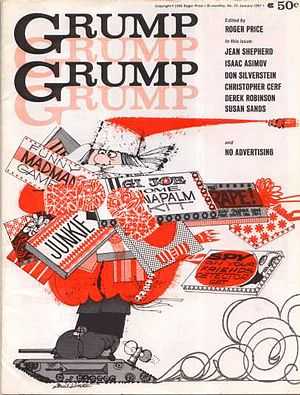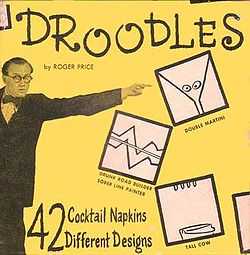Roger Price (comedian)

Roger Price (March 6, 1918 – October 31, 1990) was an American humorist, author and publisher, who created Droodles in the 1950s, followed by his collaborations with Leonard Stern on the Mad Libs series. Price and Stern, who met when they were writers on the Tonight show, became partners with Larry Sloan in the publishing firm Price Stern Sloan.
Price was born in Charleston, West Virginia. During the 1940s, he wrote for The Bob Hope Show and worked with Hope on a newspaper humor column. On Broadway he performed in Arthur Klein's musical revue, Tickets, Please! (1950), and he contributed sketch material to Leonard Sillman's New Faces of 1952. Price hosted the television panel show How To (1951), and he was a panelist on other game shows of the early 1950s: Who's There?, What Happened?, That Reminds Me, The Name's the Same and What's My Line? He was the co-creator with Stanley Ralph Ross of the 1977 NBC situation comedy The Kallikaks, and he also wrote for the show.
Droodles
In 1953, Price invented Droodles, a syndicated feature which he described as "a borkley-looking sort of drawing that doesn't make any sense until you know the correct title." When Simon & Schuster published Price's Droodles in 1953, the book launched a Droodle craze that was fueled by a series of ads in college newspapers offering cash prizes for Droodles created by college students. In 1954, Price hosted a Droodles television game show with panelists Marc Connelly, Denise Lor and Carl Reiner. More Droodles were gathered in follow-up books, The Rich Sardine (1954) and Oodles of Droodles (1955). Over the years, many of the drawings (minus the author's droll commentary) have been reprinted in collections such as Classic Droodles. One of Price's original Droodles serves as the cover art for Frank Zappa's 1982 album Ship Arriving Too Late to Save a Drowning Witch. Price's other captions for that drawing include "Mother pyramid feeding her baby."
Mad Libs

The same year the Droodle was born, Price and Stern invented Mad Libs, although the first book in the series was not published until 1958. The title came about when the two were in Sardi's and overheard an actor arguing with his agent. The actor wanted to “ad-lib” an interview, but his agent thought such an approach was “mad.”
According to Stern, the concept was hatched accidentally.[1] Stern was scripting an episode for The Honeymooners in 1953 when Price came by. Stern recalled, “I was trying to find the right word to describe the nose of Ralph Kramden's new boss. So I asked Roger for an idea for an adjective and before I could tell him what it was describing, he threw out 'clumsy' and 'naked.' We both started laughing. We sat down and wrote a bunch of stories with blanks in them. That night we took them to a cocktail party and they were a great success... We were turned down by every publisher in the New York area. Publishers told us it wasn't a book and suggested we approach game manufacturers, but they also rejected us and advised us to talk to publishers. It became a well-worn path.”
Sally Lodge described the rise of Mad Libs in Publishers Weekly (March 31, 2008) after the initial 1958 publication:
- The duo found a printer and self-published 14,000 copies. Soon thereafter, Ballantine Books founder (and friend) Ian Ballantine agreed to distribute the book on a short-term basis. That first printing did not last long. Stern, then head writer and comedy director for NBC's The Steve Allen Show, suggested to Allen that they use the Mad Libs format to introduce guest stars, with the audience supplying words. Allen agreed, and on the next show he held up Mad Libs as Bob Hope was introduced (audience members described the comedian as “scintillating” and dubbed his theme song, “Thanks for the Communists”). Within days, bookstores sold out of Mad Libs. In the early 1960s, Price and Stern partnered with Larry Sloan, an old high school friend of Stern's, to create their own publishing company. Sloan became CEO of Price Stern Sloan and his partners wrote additional Mad Libs titles, gearing them toward children since much of their fan mail was from kids. With multiple titles landing on bestseller lists and the house's acquisition of other popular properties including Wee Sing, Mr. Men and Little Miss and Serendipity, Price Stern Sloan grew to be what Stern terms “the biggest publisher west of the Mississippi at the time.” In 1993, Stern and Sloan (Price had died three years earlier) sold their company to the Putnam Berkley Group.[2]
Price and Harvey Kurtzman
Price had four articles in Harvey Kurtzman's Mad in 1955–56[3] and later contributed to Kurtzman's 1960s magazine Help!. In the introduction to Mad's first paperback collection, The Mad Reader (Ballantine Books, 1954), he described Kurtzman's appearance:
- He is 5 feet 6 inches tall and has a physique that is just barely noticeable and a long expression. In fact, Harvey looks like a beagle who is too polite to mention that someone is standing on his tail. This Beagleishness has certain compensations – he is never ordered off the grass in Central Park and Pretty Girls frequently stop on the street to scratch him behind the ears.[4]
Books
Other books by Price included The Great Roob Revolution (Random House, 1970), What Not to Name the Baby and In One Head and Out the Other (Ballantine, 1954), which popularized the catchphrase "I had one grunch, but the eggplant over there." The nonsense non sequitur was immediately adopted by science fiction fandom, appearing occasionally in science fiction fanzines, as noted in Fancyclopedia II (1959):
- In Price's In One Head and Out the Other, the bible of Avoidism, his character Clayton Slope "had a clever trick of saying any conceivable sentence so that it sounded like "I had one grunch but the eggplant over there." Fans find the expression useful, too... Avoidism: Not originally fannish at all, but a philosophy devised in a rather stomach-turning book, In One Head and Out the Other, this doctrine became confused/associated with the Gandhi-following folk of Eric Frank Russell's "And Then There Were None". It inspired an APA, MYOB and an Avoidist Movement which avoided amounting to anything. Tenets are those implied by the root word. Lee Hoffman explains that three types of avoidism are distinguished: (1) pure, (2) applied, and 3) active, or Activist. In pure avoiding, one avoids everything except eating, breathing and metabolizing. In applied avoiding, one avoids as many things as possible. (Bus drivers are good at this sort of thing, like avoiding people waiting at bus stops.) Active avoidism isn't true avoidism and is practiced to Publicize the Cause, or as an exercise in Avoiding. Under active avoidism there is the subgroup Counteravoiding; to counteravoid vegetarianism, for instance, one eats meat. Leeh concluded: "A last word on Avoidism: I had one grunch but the eggplant over there." [5]
I'm for Me First (Ballantine, 1954) is a humor book about Herman Clabbercutt's plan to launch a revolutionary political party known as the "I'm for Me First" Party. Price also wrote J.G., the Upright Ape (1960), which publisher Lyle Stuart claimed was one of his worst-selling books. It was described by Robert Michael Pyle in Orion Afield (Autumn 1998):
- By chance, when I was buying Daniel Quinn’s book (Ishmael) at Powell’s Books in Portland, I first spotted Roger Price’s J.G., The Upright Ape. This 1960 novel also employs the device of the gorilla as the protagonist. J.G. is a member of a fictional high-elevation subspecies called the silver gorillas. His search for his abducted mate, Lotus, in America becomes a vehicle for sharp, witty satire of contemporary culture. "For the first time in his life, J.G. was unhappy. It required great concentration on his part, because it isn’t easy to be unhappy when you have such a tiny brain." Neither author can challenge Schaller’s and Fossey’s gorilla scholarship, but their fictions point to a conclusion that the researchers might recognize: gorillas—gentle, cooperative, environmentally benign—are in some ways better than humans.[6]
Roger Price Gallery
During the 1960s, Price opened the first New York art gallery devoted solely to cartoons, and in 1965–67 he edited his short-lived humor publication, Grump, which featured such contributors as Isaac Asimov, Christopher Cerf, Derek Robinson, Susan Sands, Jean Shepherd and cartoonist Don Silverstein.
One of Price's friends was the humor columnist Burt Prelutsky ("The Squeaky Wheel"), who recalled Price's interest in women:
- I had a friend, Roger Price, who devoted much of his life to the study of women. As part of his research, he married four of them. One of them was a Japanese woman who spoke no English. So amicable were the four divorces that Roger never paid a single dollar in alimony. Although Roger, creator of Droodles and author of In One Head and Out the Other, had a reputation as a satirist and a curmudgeon, he was extremely fond of women, and never made a secret of the fact that he found them more interesting than men. And what's more, he would add, they smell better. One day, when Roger was getting up in years, he confessed to me: "When I was young, I kept women around for sex. Now, I have sex with women in order to keep them around." [7]
At the time of his death in 1990, Price lived in Studio City, California.
In 2000, after Stern and Sloan launched another publishing company, Tallfellow Press, they acquired the rights to Droodles and reissued it as Droodles: The Classic Collection.
Listen to
Watch
References
- ↑ Stern, Leonard, Holly Gressley and Annemieke Beemster Leverenz. "50 Years of Filling in the Blanks," The New York Times, August 15, 2008.
- ↑ Lodge, Sally. "At 50, Mad Libs Continues to (verb)," Publishers Weekly, March 31, 2008.
- ↑ http://madcoversite.com/ugoi-roger_price.html
- ↑ Price, Roger. The Mad Reader. Ballantine Books, 1954.
- ↑ Eney, Dick. Fancyclopedia II. Bladensburg, Maryland: Operation Crifanac, 1959.
- ↑ Pyle, Robert Michael. “In the Shadow of Jane Goodall.” Orion Afield, Autumn 1998. Quoted in Marion W. Copeland's Apes of the Imagination: A Bibliography.
- ↑ Prelutsky, Burt. "The Squeaky Wheel," World Net Daily, March 9, 2005.
- Bowman, David (1975). "Whatever Happened to Droodles? Whatever Happened to Roger Price?". The Journal of Popular Culture 9 (1): 20–25. doi:10.1111/j.0022-3840.1975.0901_20.x.
External links
| Wikiquote has quotations related to: Roger Price (comedian) |
- Penguin Group (USA): Roger Price
- Roger Price (I) at the Internet Movie Database
- Roger Price at the Internet Broadway Database
- Mad Libs official site
| ||||||||||||||||||||||||||||||||||
|